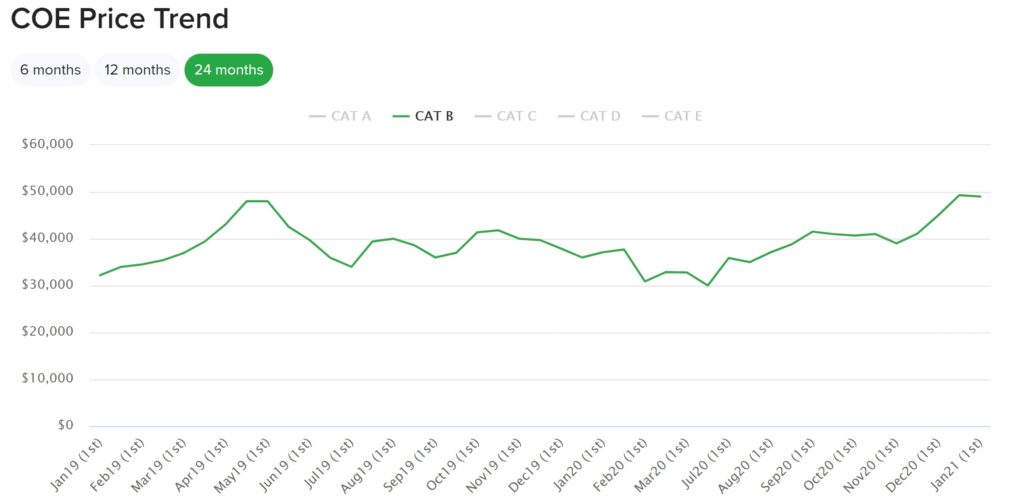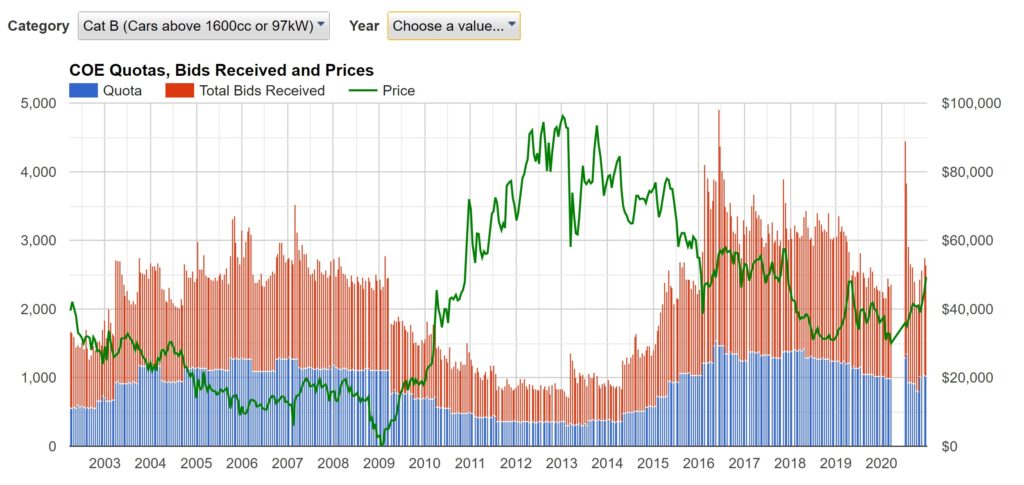“He who doesn’t make a prediction has no skin in the game.” – Mr 15HWW
When we buy a stock or an asset, we are consciously predicting that its price will rise in the future. Or vice versa. And yes, a prediction only has value when it is backed by action. Otherwise, just empty talk.
I bought a Mazda 6 on July 2019 after much internal struggle (for background, read this and this) and managed to negotiate for a Category E COE to be immediately registered to the car. For reference, the prevailing Category B COE was around $35k then.
With that purchase, I was effectively hedging against a rise in the prices of CAT B COEs in the near to mid-term. It’s been 1.5 years and despite Covid-19, my prediction has been rather spot on when we look at the chart below.

Source: Motorist.sg
If you are a towkay who changes a car every 3-4 years, this post probably isn’t for you. You might even have actually just placed a deposit at Cycle & Carriage for the new Mercedes E Class.
However, if you are a marginal buyer like me and thinking of timing the COE market to save several thousands of dollars, do mull over my short and intuitive Supply and Demand analysis for the COE market.
Supply Analysis
The COE market is similar to most markets in that it’s easier to predict the supply rather than the demand.
According to Land Transport Authority (LTA), the number of COEs are released for bidding on a quarterly basis and most of the quota comes from the vehicles deregistered over the preceding three months.
And in Singapore, since most cars are only deregistered after the 10 year COE expires, to predict the supply, we will have to look at the quotas from 10 years ago or even before.

Source: coe.sgcharts.com
As seen from the chart above, the supply of COEs has a strong inverse relationship with COE prices. From 2004 to 2009, there was consistently more than 1,000 Category B certificates during each bidding exercise and COE premiums hovered between $10k to $20k.
However, when the supply started shrinking from 2010 to 2014, prices began to steadily climb and went past $90k in 2013 when the supply was more than halved (just 300 certificates in Feb 2013).
As most of the cars registered in 2004 started to be deregistered from 2013 or 2014, the quota started increasing from 2014 onwards and went back up to 1,000 by 2016. Unsurprisingly, prices started to come down to a more reasonable $40k to $50k. If we account for inflation, it’s really not that far off from $20k in 2004.
The supply of COEs is quite predictable and at this moment in time, we are entering the lean COE quota years.
Prediction: CAT B quotas could dip below 800 for each bidding exercise by the end of 2021.
Demand Analysis
If not for lockdown and the suspension of COE bidding, I am quite sure COE prices would have plunged during May or June 2020. Just like during the 2009 Financial Crisis, when COE premiums became negligible.
However, barring huge external shocks, it’s hard to attribute any spike or dip in prices to demand factors.
The majority of car owners (especially CAT B cars) are somewhat insulated from the vagaries of the economy during this economic cycle and demand should remain consistent. With likely little or even no leisure travel in 2021, travel budgets might even spill over to car purchases.
Conclusion
If you are in the market for a car, my advice would be to start looking now as prices are likely to increase if economic sentiments continue to improve.
Prediction: By the end of 2021, CAT A prices could approach $50k and CAT B prices $65k.
If you are priced out of a new car, a viable alternative would be resale 2 year old cars since they are pegged to a cheaper Certificate of Entitlement. That’s actually what a savvy buddy of mine did about 3 months ago.
Of course, that’s provided you need/want a car. Or you can justify the cost with the added utility to your life.
Thanks for reading.
Related Articles:
The “How Much Does A Car Cost Guide” For…… Ourselves
Hi, thanks for the informative post! have a Honda Civic 1.6 that I extended 5 years COE till Aug 2023. Do you think I should sell now and get $15k for trade in with COE at around 40k, or wait till 2023. Haha wondering if you have any predictions for 2023 based on the historical supply and demand. Thanks!
Hi Matt,
Firstly, are you getting another car? Otherwise, it’s more of a question if you should drive till Aug 2023 or sell the car right now, which is more of a lifestyle question.
My take on COE in 2023 is that supply is likely to shrink further and COE premiums are likely to inch further up.
Hi, thanks for the reply! Yes will be getting another car for my family. I was wondering so as I do expect COE to rise in 2023, and if COE now is $45k for Cat B and increases to say around $70k (25k diff), would it be more worthwhile (or rather worth it, cos keeping a COE car is generally cheaper) to trade in my current car while there is still some value of around 15k ($0 at the end of 5 year COE), and factoring in $13-14k/year depreciation with the new car. Of course, will never know the actual COE prices, haha just wondering!
Hi Matthew,
Your situation is really quite tricky so I will not give advice directly. I might also just be grappling in the dark so do take what I say next with a pinch of salt.
I have an older cousin who bought his first car in 2004 when COE was hovering at $40k (pretty high then) and when his COE expired in 2014, paid $80k for another fresh COE. His latest COE will expire in 2024 and he seems to be “locked in” to a lousy cycle where he always pays high prices for his COE.
Family members have asked him to sell his car last year and get a new one to break out of the cycle but cashflow is an issue as he took a big loan for that car. So he does not have much options and I am also curious if he will get another new COE in 2024.
The good thing is that you seem to have options from now till 2023 so all the best with your decision!
What is your prediction for Motorcycle COE in 2021?
With this pseudo Circuit Breaker in place from May to June, what’s your thoughts on the COE movement from now until end of year?
Hi Kai,
Likely no change to my thoughts. With the smaller supply, the COE market will largely be supported by the top 20%, who are immune to the economic effects of the pandemic.